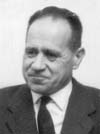LOSSKY VLADIMIR
Η Θεολογική έννοια του Ανθρώπινου Προσώπου
Essences and Energies
Biographical Note
 Vladimir Lossky ( 26 May 1903, Göttingen-7 February 1958, Paris) studied at Univ. of St. Petersburg, 1919-22; studied in Prague, 1922- 24; studied medieval philosophy, Sorbonne, 1924-26. Career: lived and wrote in Paris, 1926-58; professor of dogmatic theology, St. Deny's Institute of Orthodox Theol., Paris, 1945-53;
Vladimir Lossky ( 26 May 1903, Göttingen-7 February 1958, Paris) studied at Univ. of St. Petersburg, 1919-22; studied in Prague, 1922- 24; studied medieval philosophy, Sorbonne, 1924-26. Career: lived and wrote in Paris, 1926-58; professor of dogmatic theology, St. Deny's Institute of Orthodox Theol., Paris, 1945-53;
Lossky was a friend and disciple of Etienne Gilson and also counted among his friends several influential Roman Catholic theologians, including J. Daniélou, H. De Lubac, Y. Congar, and L. Bouyer. He was the author of some influential books, most notably The Mystical Theology of the Eastern Church ( 1957), which is the type of neopatristic synthesis valued and desired by Georges Florovsky.
Lossky’s emphasis on the filioque dispute, so marked in The Mystical Theology, has been read by other scholars, Orthodox and Western, both as somewhat exaggerated and as owing as much to Théodore de Régnon's characterizations of Greek-Latin differences as to Lev Platonovich Karsavine's. His attempt to discover all the differences between Eastern and Western Christianity, and as a result their schism itself, as deriving from this Latin addition to the Nicene Constantinopolitan Creed is thus surely an overstatement. By the same token, however, he takes the Trinity with utmost seriousness. The integration of dogmatic theology with spirituality and mysticism is something that he insists upon throughout all of his works, and this insistence, together with a style of writing one can only describe as intense, continues to make him an exciting and significant author. Then, too, Lossky is one of the very few modern Orthodox writers with a primary interest in the Medieval Latin West. His work on the knowledge of God in Meister Eckhart, which he was completing when he died, remains a standard in the field. In spite, then, of his frequently polemical stance and sharp expressions regarding Western Christianity -- and one does well to recall that he was often responding to yet more dismissive views of Eastern thought -- his work is catholic in its interests, inherently "Western" in its cultural setting, and his interests far broader than those of a narrow polemicist.
Bibliography
A. The Mystical Theology of the Eastern Church (1944; Cambridge, 1957); The Vision of God, trans. A. E. Moorhouse ( London, 1963); In the Image and Likeness of God, trans. J. H. Erickson and T. E. Bird ( New York, 1974); Orthodox Theology: An Introduction, trans. Ian and Hita Kesarcodi- Watson ( New York, 1978); with Leonid Ouspensky , The Meaning of Icons, trans. G. E. H. Palmer and E. Kadloubovsky ( New York, 1982).
Source: Biographical Dictionary of Christian Theologians. Patrick W. Carey, Joseph T. Lienhard – editors, Greenwood Press. Westport, CT. , 2000.
http://www.greenwood.com/
|











